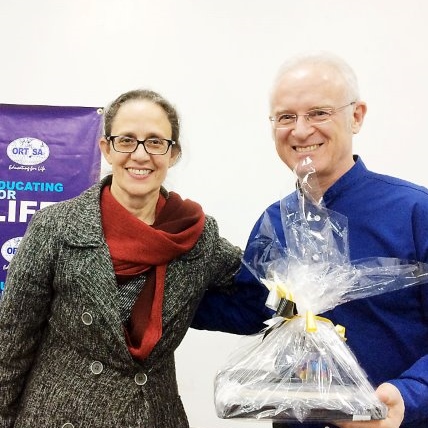
News

Stepping into the future with Arthur Goldstuck
JORDAN MOSHE
“Looking back into the past enables us to appreciate the progress we’ve made and where we are today,” said Goldstuck. “One hundred years ago, 1918 witnessed the introduction of grocery bags with handles, the first three-colour traffic light and British women getting the right to vote. While it is clear that disruption of the norm has been with us for a while, the fact remains that massive disruption is felt almost immediately today, unlike in the past.”
Goldstuck outlined the dramatic technological progress witnessed across the globe over the last number of years when he spoke at ORT SA last week. “From entertainment to automotive technology, we are advancing at a rapid rate, and continue to do so with every passing day,” he said.
Goldstuck explained just how quickly we are moving into a technologically driven future. “In the last few years alone, we’ve seen the creation of very capable electronic assistants, Smart TVs, and voice-controlled technology.Simple tasks, such as brewing a cup of coffee or turning on a pressure cooker, are now able to be carried out through the voice alone.
“The complexity of developing technology means that people feel it can only be operated by someone with an engineering degree – or by a 10-year-old.”
This being the case, companies are trying to make technology as user-friendly and seamlessly integrated into everyday objects as possible. “Fitbits and fitness apps will be replaced by clothes designed to fulfil the same purpose,” said Goldstuck.
“After the failure of Google Glass [a wearable computer in the form of a pair of prescription glasses, which flopped because of privacy and usability issues], companies realised that consumers want to use modern technology without all the additional gadgets. People looked like creeps in those glasses, and this speaks to the need to make modern technology as aesthetically pleasing as possible.
“By integrating microphones and chips into everyday clothes, perhaps the burden of carrying devices can be eliminated and people can look good while using them.”
Not all people are reluctant to allow new technology into their lives, however. In Japan, 20 000 robots are being used to serve customers at restaurants across the country, and the public couldn’t be happier. “Instead of feeling embarrassed to ask a human waiter for extra-large portions and a diet cooldrink,” explained Goldstuck, “customers can give their orders to non-judgemental robots, which will bring them their food without passing comment.
“Some people are prejudiced against robots because they’re against the idea of being replaced – but the experience of dealing with robots suggests that people can be better served and have their needs met.”
The message conveyed by all this advancement, said Goldstuck, is that there is not only one next best thing. “We are witnessing unstoppable change in our world every day. Progress in various sectors has the capacity to overturn norms and affect the reality which we have come to accept.
“When these changes in various areas affect our lives together, the very landscape in which we live and operate can be altered in a way we never thought possible.”
According to experts of Cisco, a worldwide leader in IT and networking, 2022 will see cars take to sky (Dubai has already licensed them for release); smartphones will be phased out in 2025; text by thinking will be a reality by 2027; and the human brain will be simulated by 2028, making diagnoses of mental illnesses possible without invasive surgery. “The 2030s will make the 2020s look like nothing happened,” said the company’s former CEO, Rowan Trollope.
While many of us dismiss science fiction as speculative nonsense, Goldstuck maintains that the genre is a great indicator of what the future business landscape will look like. At World Wide Worx alone, people who train to be data detectives, artificial intelligence (AI) identity managers, brain auditors and chief technology trust officers will be in demand. “Top jobs on LinkedIn will include body-part makers, nano medics, waste data handlers and avatar managers,” explained Goldstuck. “The highest paying jobs will include gene sculptors, quantum surgeons, AI talent lawyers and robot psychologists. Your choices will be almost endless.”
And this future begins now. With the adoption of AI, 1 730 companies in the industry have received funding in the last eight months alone. In Israel, $3.5 billion (R44 billion) – a full 15% of the global budget for the industry – was invested in companies working with AI.
“Every day we find new ways to change our world,” concluded Goldstuck. “What we know today may be completely different tomorrow, and the future of technological advancement – which always seemed so far off – is upon us right now.”




